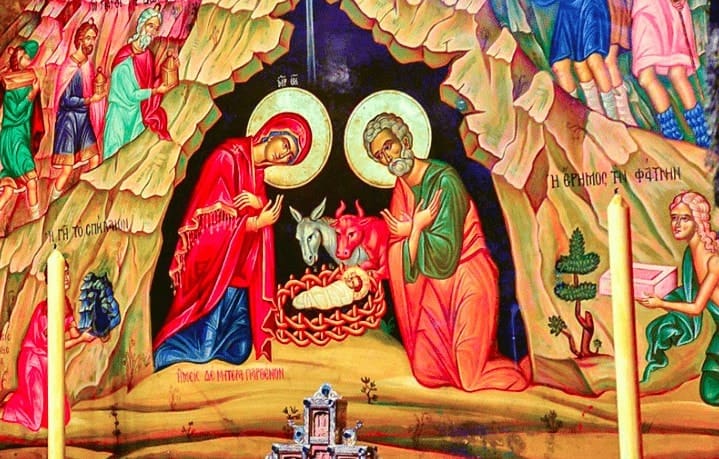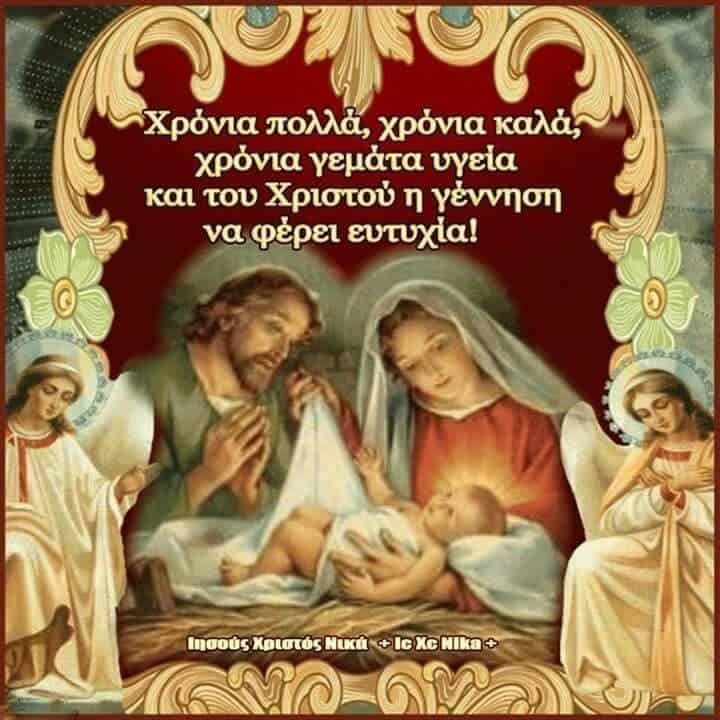Our Lord Jesus Christ, the Saviour of the world, was born of the Most Holy Virgin Mary in Bethlehem during the reign of the emperor Augustus (Octavian). Caesar Augustus decreed that a universal census be taken throughout his Empire, which then also included Palestinian Israel.

The Jews were accustomed to being counted in the city from where their family came. The Most Holy Virgin and the Righteous Joseph, since they were descended from the house and lineage of King David, had to go to Bethlehem to be counted and taxed.
They found no room in Bethlehem at any of the city’s inns. Thus, the God-Man, the world's Saviour, was born in a cave that was used as a stable.
“I behold a strange and most glorious mystery,” the Church sings with awe, “Heaven, a Cave; the Virgin the Throne of the Cherubim; the Manger a room, in which Christ, the God Whom nothing can contain is laid.” (Irmos of the 9th Ode of the Nativity Canon).
Having given birth to the divine Infant without travail, the Most Holy Virgin “wrapped Him in swaddling clothes and laid Him in a manger” (Luke 2:7). In the stillness of midnight (Wisdom of Solomon 18:14-15), the proclamation of the birth of the Savior of the world was heard by three shepherds watching their flocks by night.
An angel of the Lord (Saint Cyprian says this was Gabriel) came before them and said: “Fear not: for behold, I bring you good tidings of great joy, which shall be to all people. For unto you is born this day in the city of David a Savior, Who is Christ the Lord” (Luke 2:10-11). The humble shepherds were the first to offer worship to Him Who condescended to assume the form of a humble servant for the salvation of mankind. Besides the glad tidings to the Bethlehem shepherds, the Nativity of Christ was revealed to the Magi by a wondrous star. Saint John Chrysostom and Saint Theophylactus, commenting on Saint Matthew’s Gospel, say that this was no ordinary star. Rather, it was “a divine and angelic power that appeared in the form of a star.” Saint Demetrius of Rostov says it was a “manifestation of divine energy” (Narrative of the Adoration of the Magi). Entering the house where the Infant lay, the Magi “fell down, and worshipped Him: and when they had opened their treasures, they presented Him gifts: gold, and frankincense, and myrrh” (Mt. 2:11).

In the Apostolic Constitutions (Section 3, 13) it says, “Brethren, observe the feast days; and first of all the Birth of Christ, which you are to celebrate on the twenty-fifth day of the ninth month.” In another place, it also says, “Celebrate the day of the Nativity of Christ, on which the birth of the Word of God from the Virgin Mary for the salvation of the world gives unseen grace man.”
In the second century, Saint Clement of Alexandria also indicates that the day of the Nativity of Christ is December 25. In the third century, Saint Hippolytus of Rome mentions the Feast of the and appoints the Gospel readings for this day from the opening chapters of Saint Matthew.
In 302, during the persecution of Christians by Maximian, 20,000 Christians of Nicomedia (December 28) were burned in church on the very Feast of the Nativity of Christ. In that same century, after the persecution when the Church had received the freedom of religion and had become the official religion in the Roman Empire, we find the Feast of the Nativity of Christ observed throughout the entire Church. There is evidence of this in the works of Saint Ephraim the Syrian, Saint Basil the Great, Saint Gregory the Theologian, Saint Gregory of Nyssa, Saint Ambrose of Milan, Saint John Chrysostom, and other Fathers of the Church of the fourth century.
In a sermon which he gave in the year 385, Saint John Chrysostom points out that the Feast of the Nativity of Christ is ancient and indeed very ancient. In this same century, at the Cave of Bethlehem, made famous by the Birth of Jesus Christ, the empress Saint Helen built a church, which her mighty son Constantine adorned after her death. In the Codex of the emperor Theodosius from 438 and of the emperor Justinian in 535, the universal celebration of the day of the Nativity of Christ was decreed by law. Thus, Nicephorus Callistus, a writer of the fourteenth century, says in his History that in the sixth century, the emperor Justinian established the celebration of the Nativity of Christ throughout all the world.
Patriarch Anatolius of Constantinople in the fifth century, Sophronius and Andrew of Jerusalem in the seventh, Saints John of Damascus, Cosmas of Medium and Patriarch Germanus of Constantinople in the eighth, the Nun Cassiane in the ninth, and others whose names are unknown wrote many sacred hymns for the Feast of the Nativity of Christ, which the Church still sings on this radiant festival.
During the first three centuries, in the Churches of Jerusalem, Antioch, Alexandria, and Cyprus, the Nativity of Christ was combined with the Feast of His Baptism on January 6 and called “Theophany” (“Manifestation of God”). This was because of a belief that Christ was baptized on the anniversary of His birth, which may be inferred from Saint John Chrysostom’s sermon on the Nativity of Christ: “it is not the day on which Christ was born which is called Theophany, but rather that day on which He was baptized.”
In support of such a view, it is possible to cite the words of the Evangelist Luke who says that “Jesus began to be about thirty years of age” (Luke 3:23) when He was baptized. The joint celebration of the Nativity of Christ and His Theophany continued to the end of the fourth century in certain Eastern Churches and until the fifth or sixth century in others.
The present order of services preserves the memory of the ancient joint celebration of the Feasts of the Nativity of Christ and Theophany. On the eve of both Feasts, there is a similar tradition that one should fast until the stars appear. The order of divine services on the eve of both feast days and the feast days themselves is the same.
The Nativity of Christ has long been counted as one of the Twelve Great Feasts. It is one of the greatest, most joyful, and wondrous events in the history of the world. The angel said to the shepherds, “Behold, I bring you good tidings of great joy, which shall be to all people. For unto you is born this day in the city of David a Savior, Who is Christ the Lord. And this shall be a sign unto you: you shall find the babe wrapped in swaddling clothes, lying in a manger. Then suddenly there was with the angel a multitude of the heavenly hosts, glorifying God and saying: Glory to God in the Highest, and on earth peace, goodwill toward men.” Those who heard these things were astonished at what the shepherds told them concerning the Child. And the shepherds returned, glorifying and praising God for all the things that they had heard and seen” (Luke 2:10-20).
Thus the Nativity of Christ, a most profound and extraordinary event, was accompanied by the wondrous tidings proclaimed to the shepherds and to the Magi. This is a cause of universal rejoicing for all mankind, “for the Savior is Born!”
Concurring with the witness of the Gospel, the Fathers of the Church, in their God-inspired writings, describe the Feast of the Nativity of Christ as profound and joyous, serving as the basis for all the other Feasts.
Happy Name Day
